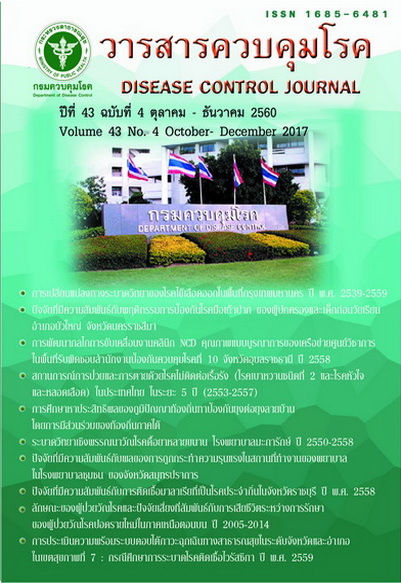Factors associated with malaria infection of endemic area in 2015, Ratchaburi Province
DOI:
https://doi.org/10.14456/dcj.2017.8Keywords:
malaria infection, risk factors, endemic areaAbstract
This is an analytical case-control study. The research aimed to identify the factors of malaria infection in Ratchaburi’s population. There were 440 participants in the study who were 15 years old or older who have lived in Ratchaburi Province; divided into two groups, 220 cases group of malaria infection who were infected during 1st January to 31th December 2015, and 220 controls group of non-malarial infected (control group). Data were collected by interview questionnaire using interviewing. Multiple conditional logistic regression was analyzed to determine the relationship with malaria infection and presented by OR with 95% confidence interval. The results showed that factors significantly associated with malaria infection (p<0.05) were: not receiving information about malaria (ORadj = 2.15, 95% CI: 1.052-4.408), duration of living in the area less than 16 years (ORadj = 2.96, 95% CI: 1.254-6.978), having workplace in the forest or garden and near water resource (ORadj = 4.06, 95% CI: 1.812-9.087), not using nets (ORadj = 2.39, 95% CI: 1.146-4.986), entering and staying overnight in the forest or garden and near water reservoir (ORadj = 3.45, 95% CI: 1.672-7.102), unsprayed house (ORadj = 2.76, 95% CI: 1.118-6.821) and regular defecation in the forest or garden and near water reservoir (ORadj = 3.47, 95% CI: 1.787-6.740) and the knowledge and perception did not significantly associate with malaria infection (adjusted OR = 1.70, 95% CI: 0.930-3.098). The malaria risk might be reduced by the active surveillance system for screening population at risk crossing the Thai-Myanmar border or staying overnight in risk area, promotion of long-lasting insecticidal nets or hammock nets, mosquito repellent when defecation outside the home, indoor residual spraying, malaria information media in local language by development a network of foreign volunteers to provide
Downloads
References
2. ยงยุทธ ยุทธวงศ์, ศิรศักดิ์ เทพาคำ, ศศิธร เทศน์ อรรถภาคย์. มาลาเรียภัยมืดที่โลกลืม. กรุงเทพ มหานคร: สำนักงานพัฒนาวิทยาศาสตร์และเทคโนโลยี แห่งชาติ; 2546.
3. World Health Organization. World malaria report 2015. France: World Health Organization; 2015.
4. พัชนา เฮ้งบริบูรณ์พงศ์, ชัชวาล จันทรวิจิตร, ไพจิตร ปวะบุตร, ณรงค์ศักดิ์ หนูสอน, ทวีศักดิ์ ศิริ ไพบูลย์, อรพิน กฤษณเกรียงไกร. พฤติกรรมการ ป้องกันตนเองจากโรคมาลาเรียของแรงงานต่างด้าว ในเขตชายแดนไทย-พม่า. วารสารสาธารณสุข มหาวิทยาลัยบูรพา 2550;2:137-45.
5. สำนักระบาดวิทยา. สรุปรายงานการเฝ้าระวังทาง ระบาดวิทยา ประจำปี 2558 [อินเทอร์เน็ต]. [สืบค้นเมื่อ 22 มี.ค. 2559]. แหล่งข้อมูล: http:// www.boe.moph.go.th/Annual/AESR2015/in¬dex.php
6. รุ่งระวี ทิพย์มนตรี, นารถลดา ขันธิกุล. ความรู้เรื่อง ไข้มาลาเรียสำหรับอาสาสมัครสาธารณสุข. นนทบุรี: ชุมนุมสหกรณ์การเกษตรแห่งประเทศไทย; 2555.
7. สุภาวดี พวงสมบัติ, นพรัตน์ มงคลางกูร, ชำนาญ ปินนา. หลักสูตรอบรมวิทยากรเพื่อการยับยั้งการแพร่เชื้อ มาลาเรียสำหรับทีม SRRT ระดับตำบล. พิมพ์ครั้งที่ 2. นนทบุรี: ชุมนุมสหกรณ์การเกษตรแห่ง ประเทศไทย; 2557.
8. World Health Organization. Achieving the malaria MDG target: reversing the incidence of malaria 2000-2015. France: World Health Organization; 2015.
9. สำนักโรคติดต่อนำโดยแมลง. ยุทธศาสตร์การกำจัด โรคมาลาเรีย พ.ศ. 2560-2569 [อินเทอร์เน็ต]. [สืบค้นเมื่อ 22 มี.ค. 2559]. แหล่งข้อมูล: http:// www.thaivbd.org/n/projects/download/128
10. Schlesselman J. Case-control studies. New York: Oxford University; 1982.
11. จตุพร พงศ์ศิริ. ปัจจัยที่มีความสัมพันธ์กับการ ติดเชื้อไข้มาลาเรียของประชาชนในชุมชนพื้นที่ ชายแดน ไทย-พม่า อำเภอแม่สะเรียง จังหวัดแม่ฮ่องสอน [วิทยานิพนธ์ปริญญาสาธารณสุขศาสตร มหาบัณฑิต]. เชียงใหม่: มหาวิทยาลัยเชียงใหม่; 2551. 65 หน้า.
12. Hsieh FY, Bloch DA, Larsen MD. A simple method of sample size calculation for linear and logistic regression. Stat Med 1998;17:1623- 34.
13. Kesteman T, Rafalimanantsoa SA, Razafiman¬dimby H, Rasamimanana HH, Raharimanga V, Ramarosandratana B, et al. Multiple causes of an unexpected malaria outbreak in a high-trans¬mission area in Madagascar. Malar J 2016;15:57.
14. Prathiba M, Silva D, Marshall JM. Factors contributing to urban malaria transmission in sub-saharan Africa: a systematic review. J Trop Med 2012;doi:10.1155/2012/819563.
15. Kreerat P. Risk factors associated with malaria infection: a study in Sukhirin District, Narathi¬was Province [dissertation]. Bangkok: Mahidol University; 2004. 67 p.
16. อัญชลี แนวราช. ปัจจัยที่เกี่ยวข้องต่อพฤติกรรมการ ป้องกันโรคมาลาเรียของตำรวจตระเวนชายแดนที่ 34 จังหวัดตาก [วิทยานิพนธ์ปริญญาวิทยาศาสตร มหาบัณฑิต]. ปทุมธานี: มหาวิทยาลัยศรีนครินทรวิโรฒ; 2550. 131 หน้า.
17. Inchana W, Kamchoo K, Wetasin K. Factors as¬sociated with malaria infection in Vibhavadi District, Surat Thani Province, southern Thai¬land. J Trop Med Parasitol 2013;36:49-57.
18. เกษณี กลัดพ่วง. ปัจจัยที่มีความสัมพันธ์กับการเกิด โรคมาลาเรียในประชากรต่างด้าวที่มีการย้ายถิ่น [วิทยานิพนธ์ปริญญาวิทยาศาสตรมหาบัณฑิต]. กรุงเทพมหานคร: มหาวิทยาลัยมหิดล; 2545. 149 หน้า.
19. รุ้งลาวัลย์ เจษฎาฐิติกุล. ปัจจัยที่มีความสัมพันธ์กับ การป่วยเป็นโรคมาลาเรียของประชาชนในอำเภอ สวนผึ้ง จังหวัดราชบุรี [วิทยานิพนธ์ปริญญาวิทยา ศาสตรมหาบัณฑิต]. ปทุมธานี: มหาวิทยาลัยศรี นครินทรวิโรฒ; 2546. 159 หน้า.
20. อริศรา เจริญปัญญาเนตร. การแพร่ระบาดและการ วิเคราะห์พื้นที่เสี่ยงของโรคมาลาเรียบริเวณชายแดน ไทย-พม่า ในอำเภอเมืองแม่ฮ่องสอน [วิทยานิพนธ์ ปริญญาวิทยาศาสตรมหาบัณฑิต]. เชียงใหม่: มหาวิทยาลัยเชียงใหม่; 2544. 237 หน้า.
21. Ernst KC, Lindblade KA, Koech D, Sumba PO, Kuwuor DO, John CC, et al. Environmental, socio-demographic and behavioural determinants of malaria risk in the western Kenyan highlands: a case-control study. Trop Med Int Health 2009;14:1258-65.
22. Haque U, Magalhães RJS, Mitra D, Kolivras KN, Schmidt WP, Glass GE, et al. The role of age, ethnicity and environmental factors in modulating malaria risk in Rajasthali, Bangladesh. Malar J 2011;10:367-73.
23. รัศมี ศรีชื่น. ปัจจัยเสี่ยงของการติดเชื้อมาลาเรียใน พื้นที่ชายแดนไทย-สหภาพเมียนมาร์ จังหวัดระนอง [วิทยานิพนธ์ปริญญาสาธารณสุขศาสตรมหาบัณฑิต]. ขอนแก่น: มหาวิทยาลัยขอนแก่น; 2548. 94 หน้า.
24. ประมวล สะภา. ปัจจัยที่มีความสัมพันธ์กับการป่วย ด้วยโรคมาลาเรียในพื้นที่อำเภอสมเด็จ จังหวัดกาฬสินธุ์ ระหว่างปี 2555-2557 [วิทยานิพนธ์ ปริญญาสาธารณสุขศาสตรมหาบัณฑิต]. ขอนแก่น: มหาวิทยาลัยขอนแก่น; 2559. 120 หน้า.
25. ประยุทธ สุดาทิพย์. ปัจจัยเสี่ยงของการป่วยเป็นไข้ มาลาเรียชนิดพลาสโมเดียมฟัลซิปารัมซ้ำในผู้ป่วย มาลาเรียที่มารับการรักษา ณ มาลาเรียคลินิก [วิทยา นิพนธ์ปริญญาวิทยาศาสตรมหาบัณฑิต]. กรุงเทพ มหานคร: มหาวิทยาลัยมหิดล; 2541. 80 หน้า.
26. Alemu A, Tsegaye W, Golassa L, Abebe G. Urban malaria and associated risk factors in Jimma town, south-west Ethiopia. Malar J 2011;10:173-82.
27. Ayele DG, Zewotir TT, Mwambi HG. Preva¬lence and risk factors of malaria in Ethiopia. Malar J 2012;11:195-203.
Downloads
Published
How to Cite
Issue
Section
License
Articles published in the Disease Control Journal are considered as academic work, research or analysis of the personal opinion of the authors, not the opinion of the Thailand Department of Disease Control or editorial team. The authors must be responsible for their articles.






